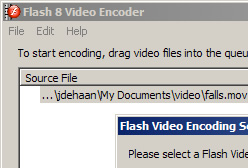Using Video and FLV Encoding in Flash MX 2004 and Flash 8
Using Video and FLV Encoding in Flash MX 2004 and Flash 8
Flash Professional 8 provides several new video features to help you create high-quality video presentations using Flash. Flash encodes video files using the On2 VP6 video codec. The On2 VP6 codec provides superior video quality using the smallest possible file size, and also enables you to use video with alpha channels in Flash. You must use Flash Player 8 to play back video that’s encoded with the On2 VP6 codec. Different Flash Player versions support Flash Video (FLV) files depending on how they were encoded (see Table 1).
| Codec | SWF File Version (Publish Version) | Flash Player Version (Required for Playback) |
|---|---|---|
| Sorenson Spark | 6 | 6, 7, or 8 |
| 7 | 7, 8 | |
| On2 VP6 | 6 | 8* |
| 7 | 8 | |
| 8 | 8 |
*If your SWF file loads an FLV file, you can use the On2 VP6 video codec without having to republish your SWF file for Flash Player 8, as long as users use Flash Player 8 to view your SWF file. Only Flash Player 8 supports publish and playback of On2 VP6 video.
The Video Import wizard has been improved in Flash 8 to help you deploy video content for embedded, progressively downloaded, and streaming video delivery. You can import video stored locally on your computer or video already deployed to a web server or Flash Media Server. You can create applications that play back embedded video or ones that progressively download FLV files at runtime.
To improve the workflow for creating FLV files, Flash Professional 8 includes a new, stand-alone video encoder that enables you to batch-process video encoding, enabling you to encode several video files using the same settings (see Figure 11). Flash 8 Video Encoder also enables you to edit video files, such as embed cue points, crop the video’s frame size, and specify the video’s dimensions. Cue points dispatch events when the FLV file plays at runtime, which enables you to call functions within the presentation. For example, you can listen for these events and write code to create a presentation that interacts with or synchronizes to the video, such as captions or animations.
Note: You can use cue points in conjunction with the new FLVPlayback component or a video object on the Stage.

Figure 11. The stand-alone Flash 8 Video Encoder includes the On2 VP6 codec, which produces high-quality FLV files.
As with Flash MX Professional 2004, you can install the FLV QuickTime Export plug-in to encode FLV files if you have Flash Professional 8 and QuickTime 6.1.1 installed on your computer. You use the FLV QuickTime Export plug-in to export FLV files from supported video editing applications, such as Avid Xpress DV, Adobe After Effects 6.5, and Apple Final Cut Pro. You can then import these FLV files directly into a FLA document or a SWF file at runtime.
Alpha channels display video where parts of the video frame are removed (such as the background) and saved as a transparent layer. This lets you overlay the video on top of other content, such as animations, graphics, or other videos. For example, a common use of alpha channels is to record a video clip of a presenter using a blue screen as a backdrop. You can use specialized software to remove that color of blue from the video file so that part of the frame is transparent, and then render the video with that transparency intact (an alpha channel). The On2 VP6 codec supports encoding FLV files with an alpha channel, so the presenter can be placed in front of other content in your Flash application, which serves as the backdrop to the video.


Comments